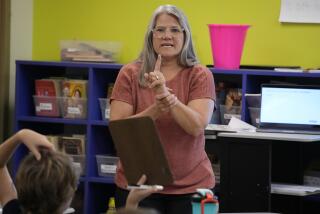Everyday Calculations Add Up in Quest to Improve Math Skill : Learning: Parents are better at passing along their love of reading than at instilling fluency in arithmetic. But each day offers opportunities.
- Share via
For years, parents have been urged to establish a reading routine at home. This includes reading to their children, encouraging their children to read regularly and modeling their own use of reading for their children.
An at-home reading habit helps build a child’s success as a reader because reading is perceived as being important and valued by their family. But at-home mathematics generally has not been given the same attention, and some educators believe that it should.
In 1989, the National Council of Teachers of Mathematics published curriculum standards for math education. These standards emphasize critical thinking and problem-solving with a focus on math in the real world. Some schools are beginning to adopt these standards and adapt their curriculum.
Meanwhile, some teachers are encouraging parents to share with their children the mathematics they use daily, just as they have been encouraged to do with reading. It can be a difficult task.
Although adults use mathematics every day, these calculations are usually invisible--done in our heads. As a result, children do not end up seeing, hearing or knowing about the problem-solving that adults around them engage in on a regular basis.
In addition, children often react to mathematics by saying, “I don’t get it” or “When am I ever going to use this?” This is generally the result of math education that focuses on rote computation, and as a result, American students do not realize the relevance of mathematics in their daily lives.
Elisabeth Keim, a kindergarten-first grade teacher at Public School 234 in New York, says one way parents can encourage the use of mathematics is through well-selected books they can use at home.
Parents should look for books grouped by math concepts with simple activities and games requiring few materials, Keim said. In addition, the books should provide an explanation of what math educators are trying to do today.
“City Math” and “Pizza Math” are two books in Time-Life’s I Love Math series ($13.95 each). In a letter to parents, the editors give examples of how math is in everything children do: “It can be found at the grocery store, at a soccer game, in the kitchen, at the zoo, even in their own bodies.”
The editors go on to explain that “math is much more than manipulating numbers; the goal of math education today is to help children become problem-solvers. This means teaching kids to observe the world around them by looking for patterns and relationships, estimating, measuring, comparing and using reasoning skills.”
The I Love Math series attempts to meet these objectives through interactive books designed to engage children in critical thinking and problem-solving activities.
Each chapter of “City Math” and “Pizza Math” focuses on a different concept, usually presented in a story format with its own characters, such as Professor Guesser, a female cat detective who appears in both books.
The books’ inside covers feature a game board with rules for playing. Throughout each book, there are notes on the bottom of the pages that inform parents what concepts are being emphasized, give ideas for extensions and answers to problems.
The material is designed for children in kindergarten through second grade and is to be used by parents and children together. (The reading level is too difficult for most children in this age group to handle on their own.)
Although these books can be visually overwhelming, the text helps readers become engaged in the activities presented.
“Circles” by Catherine Sheldrick Ross (Addison-Wesley Publishing Co., $9.95) includes 40 activities for 8- to 14-year-olds in comic, full-color art. This book provides ideas for exploring geometric shapes in order to learn how spheres, cones, cylinders and other shapes look and behave. It also points out where these shapes exist in our lives.
Throughout the book are examples from history, magic tricks, secret codes, and arts and crafts ideas relating to circles. Some of the pages seem overcrowded and children under 10 may need assistance in reading the book. But the activities in “Circles” should provide hours of enjoyment for families to do together.
Also available: “Games for Math: Playful Ways to Help Your Child Learn Math” by Peggy Kaye (Pantheon Books, $10.95).
More to Read
Sign up for Essential California
The most important California stories and recommendations in your inbox every morning.
You may occasionally receive promotional content from the Los Angeles Times.













